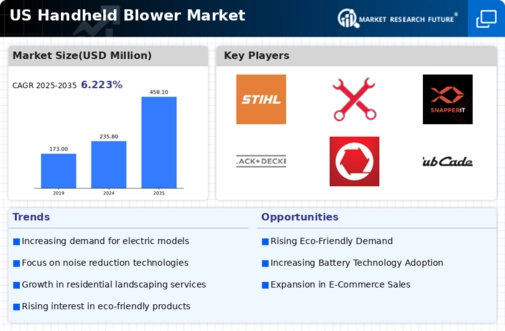Rising Popularity of Landscaping Services
The handheld blower market is positively influenced by the increasing popularity of landscaping services among homeowners and businesses. As more individuals opt to hire professional landscapers for outdoor maintenance, the demand for efficient tools, such as handheld blowers, rises. Landscaping companies often require reliable equipment to maintain properties effectively, leading to bulk purchases of handheld blowers. This trend is supported by data indicating that the landscaping services industry in the US is expected to reach a market size of over $100 billion by 2026. Consequently, the handheld blower market stands to gain significantly from this growing sector, as professional landscapers seek high-quality tools to meet their clients' needs.
Increasing Demand for Outdoor Maintenance Tools
The handheld blower market experiences a notable surge in demand as homeowners increasingly prioritize outdoor maintenance. This trend is driven by a growing awareness of the importance of maintaining clean and aesthetically pleasing outdoor spaces. According to recent data, the market for outdoor power equipment, including handheld blowers, is projected to grow at a CAGR of approximately 5.5% through 2026. This growth is indicative of a broader trend where consumers are investing in tools that enhance their outdoor living experience. As more individuals engage in gardening and landscaping activities, the handheld blower market is likely to benefit from this heightened interest in outdoor aesthetics and functionality.
Technological Advancements in Blower Efficiency
Technological innovations play a crucial role in shaping the handheld blower market. Manufacturers are increasingly focusing on enhancing the efficiency and performance of their products. Recent advancements in motor technology and battery life have led to the development of more powerful and energy-efficient handheld blowers. For instance, some models now feature brushless motors that provide longer run times and reduced noise levels. This shift towards advanced technology not only improves user experience but also aligns with the growing consumer preference for high-performance tools. As a result, the handheld blower market is likely to see a rise in sales as consumers seek out the latest innovations that offer superior performance and convenience.
Growing Awareness of Noise Pollution Regulations
The handheld blower market is also influenced by the growing awareness of noise pollution regulations in urban areas. As municipalities implement stricter noise ordinances, consumers are becoming more conscious of the noise levels produced by outdoor power equipment. This has led to an increased demand for quieter, more environmentally friendly handheld blowers. Manufacturers are responding by developing models that operate at lower decibel levels while maintaining performance. This trend aligns with the broader movement towards sustainable practices in outdoor maintenance. As a result, the handheld blower market is likely to see a rise in sales of quieter models that comply with local regulations, appealing to environmentally conscious consumers.
Shift Towards Lightweight and Portable Equipment
The handheld blower market is witnessing a shift towards lightweight and portable equipment, driven by consumer preferences for ease of use and convenience. As homeowners and professionals alike seek tools that are easy to maneuver, manufacturers are responding by designing handheld blowers that are lighter and more compact. This trend is particularly appealing to older consumers and those with physical limitations, as it reduces the strain associated with outdoor maintenance tasks. The handheld blower market is likely to benefit from this shift, as products that prioritize portability and user-friendliness become increasingly popular among a diverse range of consumers.

























Leave a Comment